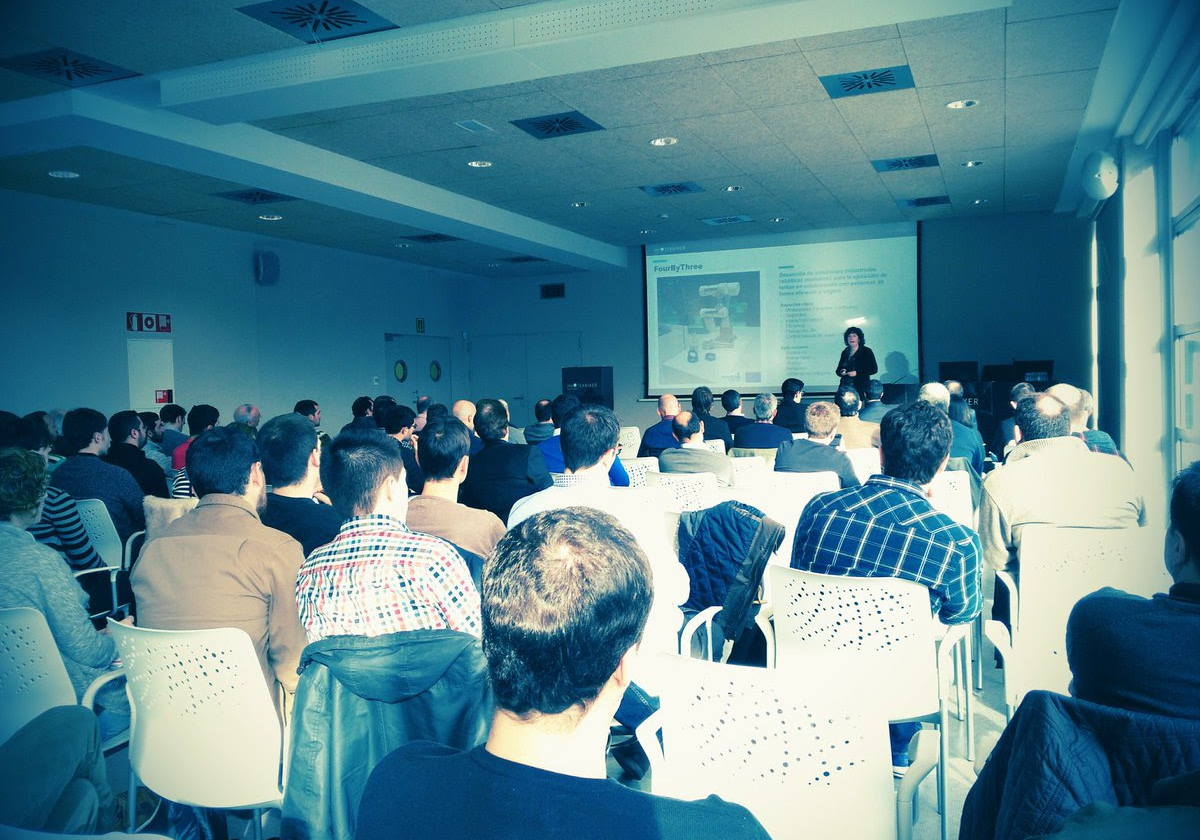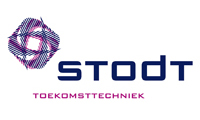Twitter Timeline
FourByThree proposes the development of a new generation of modular industrial robotic solutions that are suitable for efficient task execution in collaboration with humans in a safe way and are easy to use and program by the factory workers.
The project was active for three years, December 2014-2017.
−After the three initial prototypes, the first FourByThree robotic arm that will be used in the development of one of the four industrial cases is ready for deployment. In the coming weeks, the additional three will be available too.
The arm has been mounted in ZEMA and it is now at DFKI for final tuning. The robot will then be sent to Eibar where there will be an Integration Camp at IK4-TEKNIKER and will finally be implemented in the ALFA pilot.
In this pilot study all modular components (both hardware and software) will be used to create two different applications: collaborative part assembly and deburring. More information on implementation will be published soon.
Service robots are having enormous variability with their tasks. One thing is common with all of them: they are present in the vicinity and interact with humans. This presence and co-operation capability dictates the design of the robot arm, which is very different compared to the industrial robot designs.
The robot arm should be very light-weight so that inertia while moving will be minimized and the possible impact in case of collision is not harmful. Contradictory to this, the joint links should be as stiff as possible to meet the precision needs of the movements. If the robot arm touches humans, that should be detected by sensors. The possibility of having a configuration in the robot arm so that the arm could lock or even crush a human limb or garment with the specific joint configuration (normally between links 3 and 4) should be prevented by hardware design or at least by software limitations. The robot’s physical design should have no sharp edges in every joint. All joint corners are to be designed with smooth radiuses. All power and signal cables and tubes must be covered inside the arm so that no-one can be stuck to the cable. When making the robot assembly operations, the fixing elements should also be within the covers for the same reason.
These peculiar and contradictory design limitations, together with low hardware cost targets, have resulted in service robot designs looking quite similar. The link configurations are connected through round tubes, all control PCBs and wiring covered inside the joints, motors covered and almost nothing extending from the robot body. The covers are made of plastics and reinforced fibers, to match the light-weight goal.
Nowadays service robots are designed to be quite modular, so they can fit in different work environments. This is why the links also have a modular design. The joint torque and tube length can vary significantly. The configuration can be simulated easily with OSRF’s Gazebo simulation package, which gives the right robot arm configuration for the targeted application very easily. The software, as well as the sensor connections, can also be modular.
The links are at their simplest round tubes, to be most cost effective and not that easy to be gripped. The covers of the joints are of double curved complex shapes. They will most naturally be manufactured by 3D printing. This technology will combine light weight, seat for electronics, cover of the motor, and possibly also a fixing method.
If we look at the statistics regarding the areas where quality problems may occur, the electrical connectors are the most vulnerable in the long run. That is the reason why cables and pneumatic tubes are as long as possible and extra connectors are avoided. This brings in the feeding problem of flexible cables and pneumatic tubes inside the tubular links of the robot arm. The cables should also have extra length to match the needs of the moving robot arm. That extra length must also be handled in a predetermined form, and that is why the cables are twisted. This hassle with cable protrusion is the most complicated and common assemblability problem in service robotics. You want to avoid extra connectors and make the cables as long as possible, but inside the tubes the flexibility of the cables makes the job rather difficult. Also, at the joints the cables must be positioned in a fixed position.
Round tubes have a significant disadvantage. The round shape does not position the joints automatically and accurately to the joints on rotational axis. This needs extra attention and care. Either there must be sharp position marks or some manufactured position seats in the parts. The most difficult procedure is a calibration measurement to have the links aligned accurately.
The design of the final cover fixing elements is the second most common problem. If you apply standard fixing elements, as screws or nuts, their heads will easily pop up from the surface. Those extra features should be avoided so that the uppermost surface is flat and smooth. They are normally covered by a separate cover plate, or there is some kind of assembly construction without any fixing elements. One of this kind is the locking bayonet, being its negative feature a quite difficult manufacturing process.
Car designs nowadays look all the same when competition is extremely harsh. The same seems to be the case for service robotics hardware. The hardware corresponds mainly to the price level, although the real differences are realized by software.
Refrences:
Baya V. and Wood L.: PWC technology forcast, Issue 2, 2015: Future of robots.
Lempiäinen J. et alli: “Integration of Design and Assembly using Augmented reality”, in the book Micro Assembly Technologies and Applications, Springer 2008.
IK4-TEKNIKER hosted a workshop on collaborative robotics for industrial settings on March 9. The workshop received a very positive answer from local companies, and it was fully booked in advance.
Apart from FourByThree and some other European projects on collaborative robotics, three companies were present in the workshop: Universal Robots, Sick and Schunk. The companies brought different demonstrators, which attracted much atention.
 |
 |
During the workshop, a questionnaire was used to gather participants’ views on collaborative robotics. These are some of the most relevant results regarding FourByThree. A total of 51 answers were gathered, among which 15 respondents were already using cobots in their companies.
Among the respondents that were already using cobots:
Source: Engineering.com
The Baxter and Sawyer collaborative robots from Rethink Robotics are known as the robots with a friendly face, bringing a human touch to industrial robotics. In the video, we take a look at a new way to program them.
“You can grab our robots and teach them what to do, but sometimes that has certain limitations because if you want do something more complex, or do something with vision, training by demonstration is not enough,” said Carle Palme, senior product manager at Rethink Robotics.
“We’ve created a new software called Intera 5 that allows you to do more complex work in the same intuitive and straightforward fashion.”
In the video, Palme demonstrates a typical pick-and-place application with added vision capabilities built in to the Sawyer arm for picking randomly placed objects.
Using a built-in camera, the Sawyer is able to register frames of reference, where to pick a part and where to place it, as well as locating the parts themselves.
Another thing that we’ve added is intelligence so that if it does mis-pick, it knows it didn’t pick the part correctly and it will move on to pick up another part,” Palme said.
Following a behavior tree, a user can interpret exactly how the robot is going about the process to identify issues, Palme explained.
“One of the great things about behavior trees is that creating all of this error handling is very intuitive for the user. You can follow exactly what’s happening in tree at the time and if I wanted to change it, I can stop the robot, pull out my laptop and program any additional behavior I wanted it to do. Once I’m done I can either restart the task or continue from where I left off, which is good if I wanted to debug a task.”
Not only can you use vision systems for pick-and-place applications, but also for CNC machine tending and even part inspection.
In the video, we see an example of a Sawyer robot with a parallel gripper and vision system inspect a centrifugal pump.
“One of the things we’ve put in the system is a switch, where if it’s in the incorrect location the vision system will recognize this and the robot will go in and fix it,” Palme said. “Because it is important to understand where the engine is relative to the base frame, it takes pictures of known locations and establishes a frame of reference for the whole pump.”
Logic can be programmed for the robot to test what it fixes, ensuring it does the job correctly.
“A lot of our customers desire this capability because after an hour of inspecting the same thing over and over, people tend to make mistakes,” Palme explained. “Having a robot that does that for them is a much more robust way of ensuring quality for their end users.”
For more information about the Sawyer robot and the Intera 5 software, visit the Rethink Robotics website.
Source: Logistics Manager
DHL Supply Chain has bought four Sawyer robots to be used for packing tasks. The technology will be used flexibly across 19 of its UK co-packing and production centres; moving to support seasonal demands.
![Collaborative robot [1]](http://www.logisticsmanager.com/wp-content/uploads/2017/05/Collaborative-robot-1-300x221.jpg) DHL said it will be “upskilling its existing co-packing teams to support its growth and apply this new technology, hiring specialist roles such as robotics technician, project engineer as well as other production management roles.”
DHL said it will be “upskilling its existing co-packing teams to support its growth and apply this new technology, hiring specialist roles such as robotics technician, project engineer as well as other production management roles.”
The logistics company is also exploring how automation and robotics could be introduced to other parts of the supply chain. Following the purchase, DHL plans to invest more than £1 million in automation and robotics. over the next year.
“The introduction of collaborative robotics into logistics is something we’ve been exploring at DHL for a while,” said Simon Woodward, director of co-packing and production logistics, DHL Supply Chain. “After numerous trials, we are excited to now be offering our Sawyer robots as a solution to our co-packing customers’ needs.
“Our customers who work in consumer industries are seeing huge fluctuations in demand as consumer preferences change. The rise of ecommerce has led to a surge in the number of deliveries within the network and the flexible nature of Sawyer allows us to quickly respond to changing needs, delivering solutions to meet demands and fill labour gaps.”
















